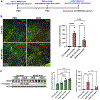Upregulation of mesencephalic astrocyte-derived neurotrophic factor (MANF) expression offers protection against alcohol neurotoxicity
- PMID: 37507360
- PMCID: PMC10906989
- DOI: 10.1111/jnc.15921
Upregulation of mesencephalic astrocyte-derived neurotrophic factor (MANF) expression offers protection against alcohol neurotoxicity
Abstract
Alcohol exposure has detrimental effects on both the developing and mature brain. Endoplasmic reticulum (ER) stress is one of the mechanisms that contributes to alcohol-induced neuronal damages. Mesencephalic astrocyte-derived neurotrophic factor (MANF) is an ER stress-responsive protein and is neuroprotective in multiple neuronal injury and neurodegenerative disease models. MANF deficiency has been shown to exacerbate alcohol-induced ER stress and neurodegeneration. However, it is unknown whether MANF supplement is sufficient to protect against alcohol neurotoxicity. Alcohol alters MANF expression in the brain, but the mechanisms underlying alcohol modulation of MANF expression remain unclear. This study was designed to determine how alcohol alters MANF expression in neuronal cells and whether exogeneous MANF can alleviate alcohol neurotoxicity. We showed that alcohol increased MANF transcription and secretion without affecting MANF mRNA stability and protein degradation. ER stress was necessary for alcohol-induced MANF upregulation, as pharmacological inhibition of ER stress by 4-PBA diminished alcohol-induced MANF expression. In addition, the presence of ER stress response element II (ERSE-II) was required for alcohol-stimulated MANF transcription. Mutations or deletion of this sequence abolished alcohol-regulated transcriptional activity. We generated MANF knockout (KO) neuronal cells using CRISPR/Cas9. MANF KO cells exhibited increased unfolded protein response (UPR) and were more susceptible to alcohol-induced cell death. On the other hand, MANF upregulation by the addition of recombinant MANF protein or adenovirus gene transduction protected neuronal cells against alcohol-induced cell death. Further studies using early postnatal mouse pups demonstrated that enhanced MANF expression in the brain by intracerebroventricular (ICV) injection of MANF adeno-associated viruses ameliorated alcohol-induced cell death. Thus, alcohol increased MANF expression through inducing ER stress, which could be a protective response. Exogenous MANF was able to protect against alcohol-induced neurodegeneration.
Keywords: MANF; alcohol neurotoxicity; endoplasmic reticulum stress; neurodegeneration.
© 2023 The Authors. Journal of Neurochemistry published by John Wiley & Sons Ltd on behalf of International Society for Neurochemistry.
Conflict of interest statement
Figures







Similar articles
-
Sex-specific effects of alcohol on neurobehavioral performance and endoplasmic reticulum stress: an analysis using neuron-specific MANF deficient mice.Front Pharmacol. 2024 Jul 26;15:1407576. doi: 10.3389/fphar.2024.1407576. eCollection 2024. Front Pharmacol. 2024. PMID: 39130640 Free PMC article.
-
MANF is neuroprotective against ethanol-induced neurodegeneration through ameliorating ER stress.Neurobiol Dis. 2021 Jan;148:105216. doi: 10.1016/j.nbd.2020.105216. Epub 2020 Dec 6. Neurobiol Dis. 2021. PMID: 33296727 Free PMC article.
-
Potential Role of MANF, an ER Stress Responsive Neurotrophic Factor, in Protecting Against Alcohol Neurotoxicity.Mol Neurobiol. 2022 May;59(5):2992-3015. doi: 10.1007/s12035-022-02786-7. Epub 2022 Mar 7. Mol Neurobiol. 2022. PMID: 35254650 Free PMC article. Review.
-
Mesencephalic astrocyte-derived neurotrophic factor (MANF) protects against Aβ toxicity via attenuating Aβ-induced endoplasmic reticulum stress.J Neuroinflammation. 2019 Feb 13;16(1):35. doi: 10.1186/s12974-019-1429-0. J Neuroinflammation. 2019. PMID: 30760285 Free PMC article.
-
Emerging Roles for Mesencephalic Astrocyte-Derived Neurotrophic Factor (MANF) in Pancreatic Beta Cells and Diabetes.Front Physiol. 2018 Oct 16;9:1457. doi: 10.3389/fphys.2018.01457. eCollection 2018. Front Physiol. 2018. PMID: 30386256 Free PMC article. Review.
Cited by
-
Unlocking the promise of MANF in diseases: Mechanistic insights and therapeutic potentials.Mol Biol Rep. 2024 Nov 16;51(1):1160. doi: 10.1007/s11033-024-10111-9. Mol Biol Rep. 2024. PMID: 39549080 Review.
-
Environmental adversity, endoplasmic reticulum stress, and neurogenesis.Neurotoxicology. 2025 Jul;109:32-45. doi: 10.1016/j.neuro.2025.05.010. Epub 2025 May 31. Neurotoxicology. 2025. PMID: 40456492 Review.
-
Protective Effect of Rosmarinic Acid on Endotoxin-Induced Neuronal Damage Through Modulating GRP78/PERK/MANF Pathway.Drug Des Devel Ther. 2025 Jan 10;19:39-50. doi: 10.2147/DDDT.S481646. eCollection 2025. Drug Des Devel Ther. 2025. PMID: 39816847 Free PMC article.
-
Sex-specific effects of alcohol on neurobehavioral performance and endoplasmic reticulum stress: an analysis using neuron-specific MANF deficient mice.Front Pharmacol. 2024 Jul 26;15:1407576. doi: 10.3389/fphar.2024.1407576. eCollection 2024. Front Pharmacol. 2024. PMID: 39130640 Free PMC article.
References
-
- Patel F and Mandal P. Effect of Alcohol on Brain Development. 2018.
-
- Ikonomidou C, et al., Ethanol-induced apoptotic neurodegeneration and fetal alcohol syndrome. Science, 2000. 287(5455): p. 1056–60. - PubMed
Publication types
MeSH terms
Substances
Grants and funding
LinkOut - more resources
Full Text Sources
Medical
Research Materials
Miscellaneous

